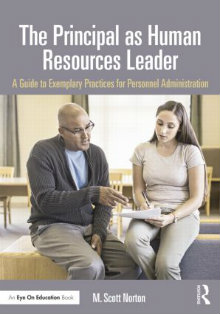The Principal as Human Resources Leader
The Principal as Human Resources Leader: A Guide to Exemplary Practices for Personnel Administration
By M. Scott Norton
(Routledge/Eye on Education, 2015 – Learn more)

The award-winning M. Scott Norton has impressive credentials, having been a teacher, curriculum coordinator, superintendent of schools, professor and chair, and now Professor Emeritus and author. However, he never seems to have been a principal, so I find it odd that he wrote an entire book on the principalship and on the extra responsibilities and accountability he believes principals should have.

Human Resources in my experience
It’s been my experience in my state of California that district personnel still handle most HR tasks. Although as principal I attended recruitment fairs at times and sat on hiring committees, this was at the invitation of the HR Assistant Superintendent who had taken extra courses and training in the laws and responsibilities of that position. I neither wanted nor had the time to do more than what I did in that area.
The best scenario is when the HR person and the principals of the district work as a team. Because of the HR person’s extra training, however, they should be, and generally are, the ones held accountable for recruitment and doing thorough background and credential checks. Norton believes it should be the principal who is solely accountable.
Recalling my first year as a principal
This book made me realize that some of the trials of my first year were caused by ineffective tools in place for human resource decisions. For example, there were no standardized questions for interviewing teacher candidates that looked for key qualities or statements. It would be helpful if Norton suggested some models. I was told I could hire all my own teachers, but soon discovered that if I didn’t hire certain people who had been with the district I would have to answer to the teacher’s union as to why. In addition, teachers from Spain had been hired and assigned to my school by the superintendent. I was new to the area and so was the HR assistant superintendent, and there was a teacher shortage. There was no time to observe a lesson before hiring, which is a good practice. Given these constraints, none of which Norton mentions, mistakes were made.
The challenges of teachers’ work-life balance
Several of my teachers were millennials, those born in the years after 1980. Norton quotes Heathfield (2013): “Managing millennials is a skill managers need to develop. The millennial quest for work-life balance and for having a life outside of work is legend.” Work-life provisions principals need to consider are work schedules, childcare provisions, eldercare assistance, health benefits, part-time flexibility work, leave provisions. This is a large number of provisions that principals need to worry about and why we need an HR district person.
“It would appear impossible to find a teacher that does not want to become a better teacher,” says Norton in chapter 3. Sadly, and partially because of this different work ethic of some teachers today (and not only millennials), I did not find this statement to hold true, although I refuse to generalize about all teachers because I found a few who were not up to par. I do agree with Norton that the principal’s role is teacher development
Helpful resources on school climate
Chapter 4 is where the book gets more useful and practical. Norton believes that when it comes to school climate, the principal is the key player. He suggests by name several valid and reliable climate surveys that can be given to staff. I think this would be an excellent way to start improving a school’s climate – which is related to higher test scores, says Norton.
I also learned about the Douglass Teacher Load Formula (Norton, 2008). Some suggestions of how to work for equity in this area would have been useful. In my experience we have tried many approaches, especially for the secondary English teacher (wholistic grading, smaller class sizes, scheduling changes), only to have them dropped after a short period, even if the teacher believes they made a difference. I like Norton’s idea of “exit interviews,” which usually are not done. The section on “Effective orientations for teachers” has some useful ideas.
Norton provides case studies for discussion, but two of these cases have the principal wanting to retain kids in their grade levels, and I’m not sure why this came up twice. Neither are possible resolutions to the problems discussed; had they been they might have shed some light on how to improve schools.
Human Resources’ specialized knowledge
This book left me with more questions than answers, and Norton has not convinced me that the principal should mainly be held accountable for human resources. There are too many constraints such as tenure laws, union contracts, the culture of the entire district (read Norton’s definitions of culture vs. climate), and schools isolated geographically from major universities.
Should principals live in their communities? Norton states that “To know the community always has been a base responsibility of the school principal.” Should they then come up from the ranks? What have been previous principal and administrator expectations in schools with high turnover in staff and/or with transient students? Norton doesn’t discuss the training of parent or community volunteers or good programs that should be in place to help school climate.
I liked having the assistant superintendent of human resources a phone call or visit away at central office. Many times I called with a question that her expertise and extra training solved. I was always happy to help interview teachers for the district pool. In other words, the human resource person at the district level did background checks, made job offers, provided district orientations to new hires, scheduled events, and even traveled out of state to recruit teachers. She also kept up on changing laws and contract negotiations and informed principals and the board. I could not have done all human resource tasks that Norton expects of the principal with all my other duties.
The most valuable parts of the book are the school climate instruments recommended and the references at the end of each chapter. Yes, schools are about people, but the principal needs a great deal of help with the hiring and recruiting and development of good teachers and support staff. It can’t be done alone, and therefore the full accountability for these tasks should not rest on the principal alone.
Dr. Mary Langer Thompson’s articles, short stories, and poetry appear in various journals and anthologies. After years of teaching middle and high school English, she worked with hundreds of beginning and experienced California teachers as a “Clinical Consultant” at UCLA, and as a public school principal.
































